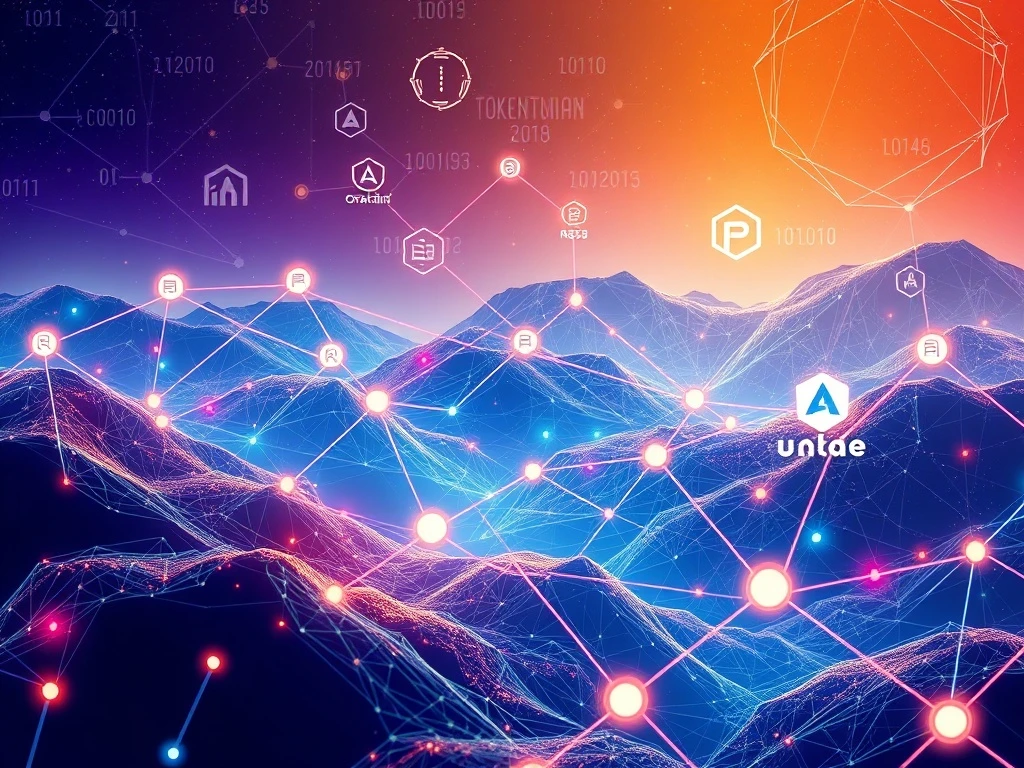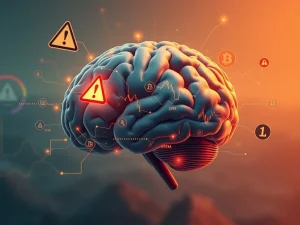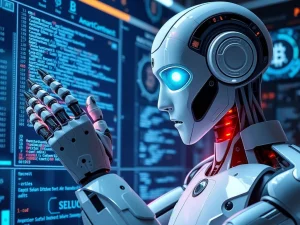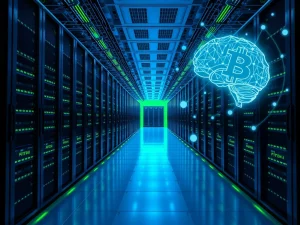Web3 Adoption Revolution: Oraichain, Pinlink, and RSS3 Unleash AI Tokenization Data Solutions

The decentralized internet, or Web3, is rapidly moving beyond speculative hype to build foundational infrastructure. As we stand in July 2025, a new wave of blockchain projects is capturing investor attention by addressing core challenges in AI computation, asset tokenization, and data accessibility. Among these, Oraichain, Pinlink, and RSS3 are emerging as critical pillars, poised to accelerate widespread Web3 Adoption by providing essential services for the next generation of decentralized applications (dApps) and AI integration.
Why is Web3 Adoption Critical for the Future?
The vision of Web3 is to create a more open, transparent, and user-centric internet, free from the constraints and data silos of centralized entities. However, achieving this vision requires robust infrastructure that can handle complex computations, manage physical resources, and provide verifiable data streams. This is where projects like Oraichain, Pinlink, and RSS3 step in, building the essential layers that make true decentralization and AI integration possible. Their focus on utility-driven models is a significant shift from the purely speculative nature of some earlier crypto projects, signaling a maturation of the ecosystem.
Oraichain: Powering the Decentralized AI Layer
Oraichain positions itself as the “intelligence layer” of Web3, directly addressing the growing demand for decentralized AI solutions. In a world increasingly reliant on machine learning, ensuring the verifiability and security of AI computations is paramount. Oraichain provides a unique framework for this, allowing developers to integrate sophisticated AI capabilities into dApps without compromising decentralization.
- Verifiable AI Computations: Oraichain’s oracle mechanism allows AI models to be executed and verified on-chain, ensuring transparency and trust in AI-driven outcomes. This is crucial for applications ranging from DeFi risk assessment to predictive analytics in supply chains.
- Scalable Data Processing: The platform tackles scalability challenges inherent in processing large datasets for AI, offering a robust environment for high-fidelity data analytics.
- AI-Powered dApps: Developers can leverage Oraichain to build dApps that incorporate advanced machine learning, creating intelligent decentralized services. Imagine dApps that can analyze market sentiment, optimize resource allocation, or even generate content based on verifiable AI.
The ORAI token is integral to this ecosystem. It serves multiple purposes:
- Staking: Secures the network and incentivizes validators to provide accurate AI computation.
- Governance: Holders participate in crucial decisions regarding the platform’s future development.
- Transaction Fees: Used to pay for AI-driven computations and data queries on the network, directly capturing value from the platform’s utility.
Oraichain’s approach makes it a foundational element for any application requiring trustworthy and decentralized AI capabilities, making it a key driver for advanced Web3 Adoption.
Pinlink: Revolutionizing Infrastructure with DePIN and AI Tokenization
The surge in AI demand has highlighted a critical bottleneck: access to affordable and decentralized computational hardware, especially GPUs. Pinlink introduces an innovative solution through its Decentralized Physical Infrastructure Network (DePIN) model. This platform aims to democratize access to computing power by tokenizing physical assets like GPUs, creating a dynamic marketplace for idle resources.
Pinlink’s model offers compelling benefits:
- Monetization of Idle Resources: Individuals and businesses with underutilized GPUs can connect them to the Pinlink network, offering their computing power for rent and earning yield. This effectively “financializes” physical infrastructure.
- Affordable AI Computation: Developers and AI companies gain access to a distributed network of computational resources, often at a lower cost than centralized cloud providers, significantly lowering entry barriers for decentralized AI development.
- Enhanced Liquidity: The tokenization process creates a liquid market for computational assets, improving resource allocation efficiency across the Web3 ecosystem.
The PIN token is the lifeblood of this marketplace, facilitating the exchange of computational resources. It enables:
- Payments: Users pay for compute power using PIN tokens.
- Rewards: Resource providers are compensated in PIN tokens for their contributions.
- Staking: Participants can stake PIN tokens to secure their role in the network and earn additional rewards.
By creating a decentralized supply chain for computing power, Pinlink is not just enabling AI Tokenization; it’s building a resilient, community-driven backbone for the entire Web3 computational landscape.
RSS3: Building the Open Data Foundation for Web3
As decentralized applications grow in complexity, their reliance on robust, structured, and open data inputs becomes increasingly critical. This is where RSS3 steps in, aiming to become the decentralized information layer for the Web3 ecosystem. From training AI models to powering decentralized social media networks and intricate dApp functionalities, accessible and verifiable data is the cornerstone.
RSS3 addresses the need for a decentralized alternative to traditional data indexing and distribution services. Its protocol focuses on:
- Decentralized Information Flow: Enabling open, censorship-resistant access to information across various Web3 platforms.
- Structured Data for AI: Providing organized and queryable data that can feed into AI models, enhancing their accuracy and reliability in decentralized environments.
- Content and Social Graph Indexing: Facilitating the indexing of decentralized content and social interactions, paving the way for truly open and user-owned social networks.
The RSS3 token plays a vital role in securing and incentivizing the network:
- Network Security: Staking RSS3 tokens helps secure the decentralized data network and ensures the integrity of information.
- Data Exchange Facilitation: The token is used to incentivize nodes to provide and maintain data, and potentially for accessing premium data streams.
- Governance: Token holders participate in the governance of the RSS3 protocol, influencing its development and future direction.
While the specific applications of RSS3 are continuously evolving, its fundamental role as a decentralized data provider makes it an indispensable component for any data-driven Web3 application, including those leveraging advanced AI Tokenization.
The Synergy: How Oraichain, Pinlink, and RSS3 Drive Innovation
Individually, Oraichain, Pinlink, and RSS3 offer compelling solutions. However, their true potential is unlocked when viewed as complementary components of a robust Web3 infrastructure stack. Imagine the following:
- An AI dApp on Oraichain requires vast amounts of verifiable data for training and execution. This data can be sourced reliably and transparently through RSS3’s decentralized information layer.
- When that Oraichain-powered AI dApp needs significant computational power for complex models, it can tap into the distributed GPU network provided by Pinlink, accessing affordable and decentralized resources.
- Pinlink itself might use RSS3 to index available hardware resources, and Oraichain for intelligent resource allocation.
This interconnectedness highlights a shift towards specialized, interoperable layers in Web3. By avoiding reliance on centralized cloud providers or traditional asset markets, these projects aim to democratize access to critical resources and foster innovation at an unprecedented scale. This collective effort is propelling Web3 Adoption forward, building a resilient and permissionless internet.
Navigating the Investment Landscape for Web3 Infrastructure
For investors, the allure of Oraichain, Pinlink, and RSS3 lies in their utility-driven models. Unlike purely speculative assets, these projects provide fundamental infrastructure that supports real-world application development, resource allocation, and information structuring. Their focus on solving existing technical and economic bottlenecks positions them to benefit significantly from the broader growth of the decentralized internet, particularly as industries seek scalable and interoperable solutions.
Key differentiators for investors:
- Problem-Solving Focus: Each project tackles a specific, critical challenge within the Web3 ecosystem – AI computation (Oraichain), decentralized hardware (Pinlink), and open data (RSS3).
- Foundational Layer: Investing in these projects is akin to investing in the core infrastructure of the internet itself, rather than just a single application.
- Long-Term Growth Potential: As Web3 matures and dApps become more sophisticated, the demand for verifiable AI, decentralized compute, and open data will only increase.
Early-stage adoption of such platforms, as emphasized by market analyses, could offer exposure to long-term industry shifts, provided these projects successfully scale their technical and economic models. Their ability to deliver on their promises will dictate their long-term success in accelerating widespread Web3 Adoption.
Conclusion: A New Era of Decentralized Innovation
The collaborative efforts of Oraichain, Pinlink, and RSS3 mark a pivotal moment in the evolution of Web3. By synergistically addressing the critical needs for decentralized AI computation, physical asset tokenization, and open data accessibility, these projects are laying the groundwork for a truly intelligent and decentralized internet. Their utility-first approach and foundational roles position them as essential catalysts for the next wave of innovation, driving genuine Web3 Adoption and shaping a future where technology serves humanity in a more equitable and transparent manner. As the digital landscape continues to decentralize, the importance of these infrastructure providers will only grow, promising a vibrant and resilient future for the Web3 ecosystem.
Frequently Asked Questions (FAQs)
Q1: What is Web3 Adoption and why is it important?
Web3 Adoption refers to the increasing use and integration of decentralized technologies like blockchain, cryptocurrencies, and dApps into mainstream society and industries. It’s important because it promises a more secure, private, and user-controlled internet, moving away from centralized control and data monopolies. It enables new forms of digital ownership, open finance, and verifiable digital interactions.
Q2: How does Oraichain contribute to decentralized AI?
Oraichain acts as the “intelligence layer” for Web3, providing a verifiable and secure framework for AI computations. It allows developers to build dApps with integrated machine learning capabilities, ensuring that AI models are executed transparently on-chain and their outputs can be trusted. This includes services like AI-powered oracles and decentralized AI marketplaces.
Q3: What is DePIN, and how does Pinlink utilize it for AI Tokenization?
DePIN stands for Decentralized Physical Infrastructure Network. Pinlink uses the DePIN model to tokenize physical assets, primarily GPUs and other computing hardware. This creates a decentralized marketplace where users can rent out their idle computing resources and earn rewards (AI Tokenization of compute power), while others can access affordable and distributed AI computation.
Q4: Why is RSS3 crucial for Web3’s data needs?
RSS3 is building a decentralized information layer for Web3, addressing the need for structured, open, and censorship-resistant data. It allows dApps, including AI applications, to access robust data inputs without relying on centralized data providers. This is vital for decentralized social media, content indexing, and ensuring data integrity across the ecosystem.
Q5: How do these three projects (Oraichain, Pinlink, RSS3) work together?
These projects are highly complementary. Oraichain can leverage Pinlink for decentralized AI computation power and rely on RSS3 for verifiable, structured data inputs to train and execute its AI models. Pinlink benefits from RSS3’s ability to index available hardware resources, and RSS3 can provide data feeds for AI models built on Oraichain. Together, they form a comprehensive stack for decentralized AI and data management, accelerating overall Web3 Adoption.









